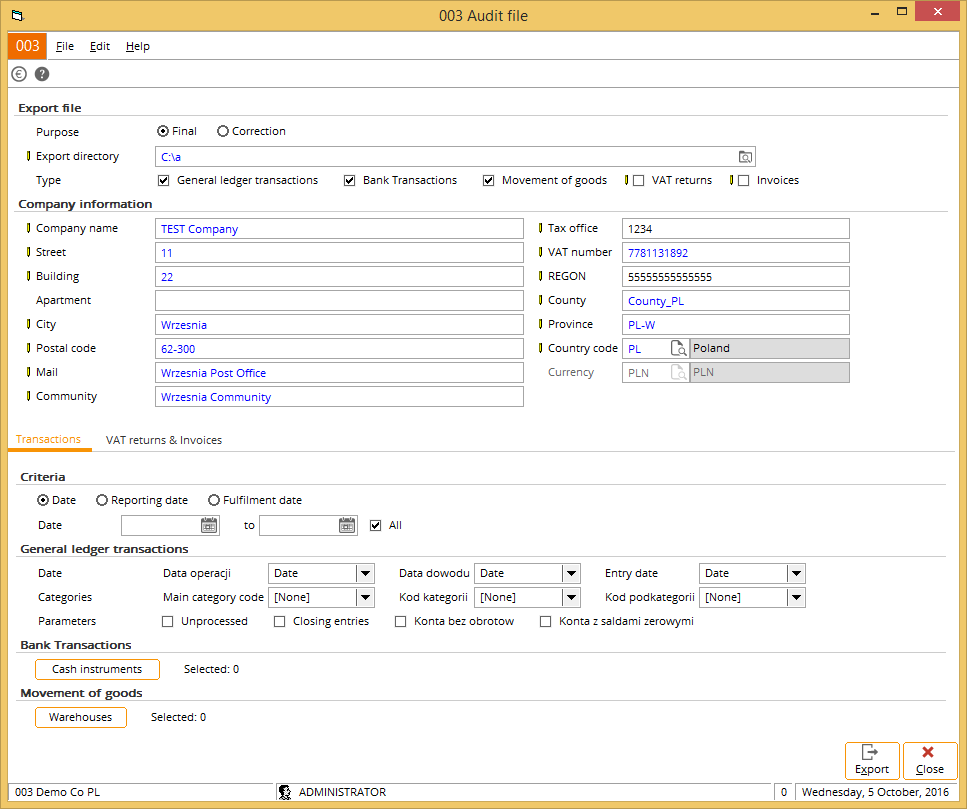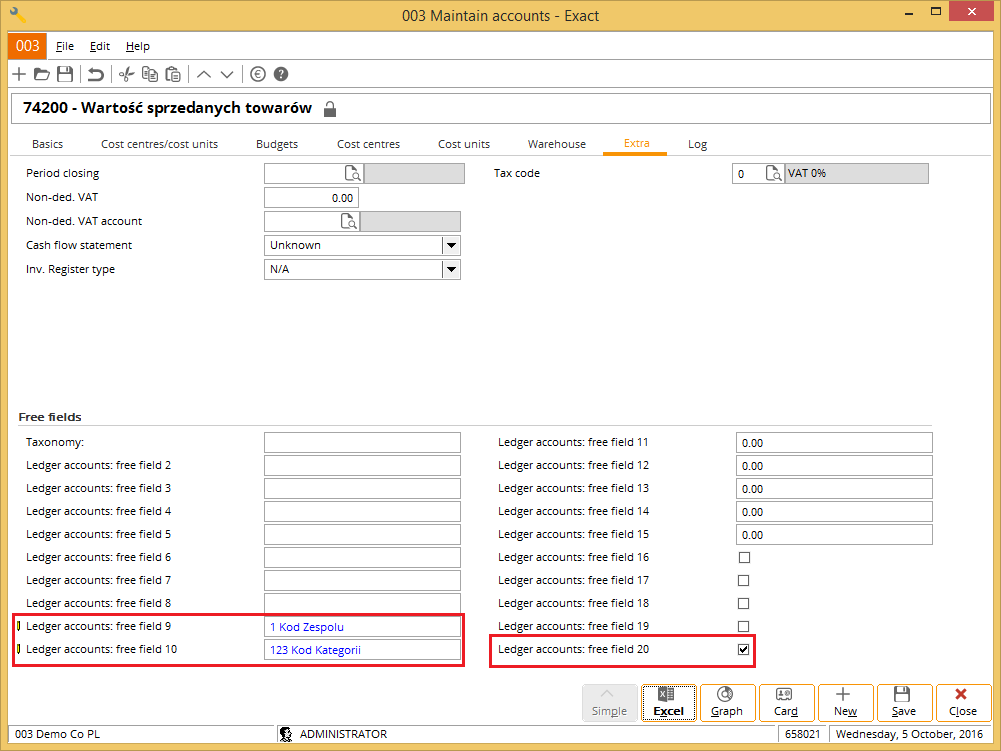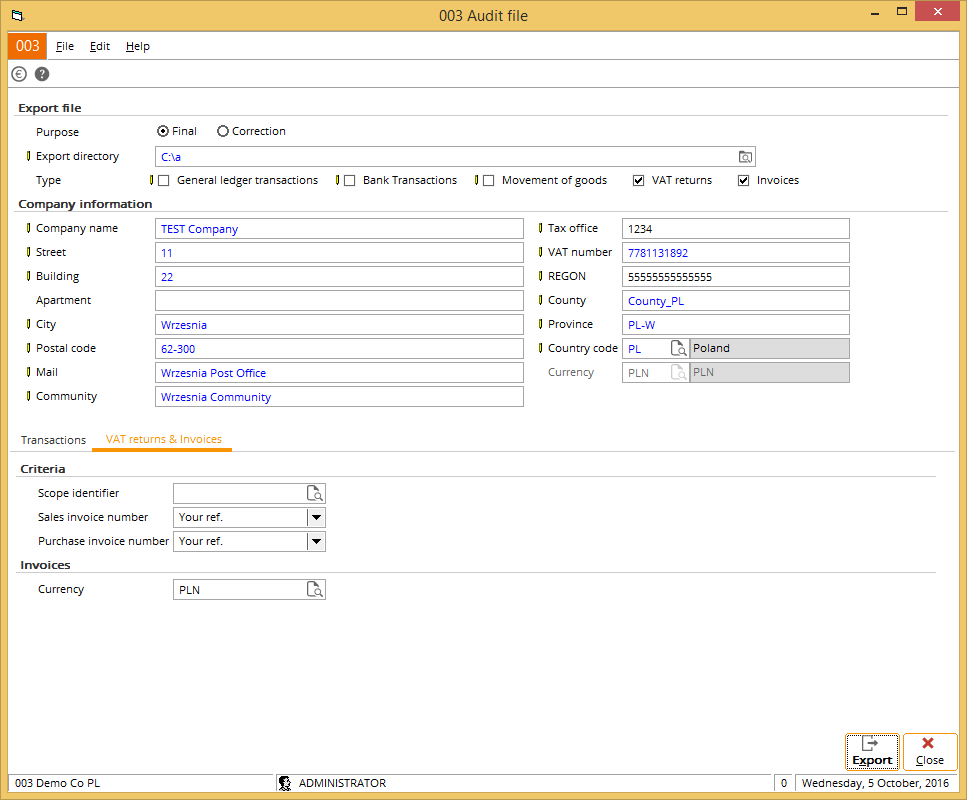Product Updates 413, 412, 411, and 410: SAF-T supported (Polish legislation)
As of July 1, 2016, VAT taxpayers in Poland need to provide an electronic file called Standard Audit File for Tax (SAF-T), or in Polish, Jednolity Plik Kontrolny (JPK), to comply with an additional reporting requirement by the Polish tax authorities. This file details specific information about their businesses for audit purposes. The implementation of this new reporting requirement will affect large enterprises, as they will no longer be allowed to submit accounting and tax documentation in any other electronic form other than SAF-T. For SMEs, the requirement will come into effect on July 1, 2018.
In this product update, Exact Globe Next now supports five of the SAF-T structures which will include the following information in the audit file:
-
Accounting records (for example, general ledger transactions)
- Bank statements (for example, bank transactions)
- Warehouse (for example, movement of goods)
- VAT register (for example, VAT returns)
- Invoices (for example, sales register)
This new enhancement is accessible via the following menu paths:
- Finance ➔ VAT / Statistics ➔ Audit file
- Accountancy ➔ Check ➔ Audit file
New sections in the Audit file screen
In the Audit file screen, you will find several sections that will be included in the SAF-T.
The sections are:
Export file section
The export directory where the generated XML files are stored is defined in this section. You can select the type of submission to be generated for the audit file, by selecting Final or Correction. You can also select which audit file type to generate, which, upon selection, will enable the relevant sections in the Transactions or VAT returns & Invoices tab.
Each audit file type has its own specific XML format. Thus, separate files will be generated accordingly.
Company information section
In this section, you can define all the relevant company information for the audit file submission. All fields are mandatory, except
Apartment.
Transactions tab

In the Transactions tab, you can select the transactions that will be reported in the audit file.
In the General ledger transactions, you can define the date type and the relevant account categories to use for the XML tags. At the Main category code (Kod zespołu) and Kod kategorii fields, you can choose one of the categories from General ledger maintenance or the option “Others”. If “Others” is selected, the values defined at the Free field 9 and Free field 10 fields in the general ledger maintenance screen will be displayed in the generated audit file, as shown in the following example:

At the Free field 9 field, the value
should be defined according to the following format:
Code (1 digit) +
space + Description
The value will be
reflected in the XML tags for the general ledger transactions, as shown in the
following:
|
XML
tag
|
Value
|
|
<KodZespolu>
|
Code
|
|
<OpisZespolu>
|
Description
(from the third character onwards)
|
At the Free field 10 field, the value
should be defined according to the following format:
Code (3 digits) +
space + Description
The value will be
reflected in the XML tags for the general ledger transactions, as shown in the
following:
|
XML
tag
|
Value
|
|
<KodKategorii>
|
Code
|
|
<OpisKategorii>
|
Description
(from the fifth character onwards)
|
Note: The text Niedostępne (Not available) will be displayed in the XML tags if the descriptions for the fields that are not defined correctly.
At the Free
field 20 field, the check box can be selected if the general ledger is for
an off balance account. When this option is selected, Pozabilansowe will be displayed in the <Typkonta> XML tag.
For Bank Transactions, the XML files are reported using the International Bank Account Number (IBAN) and are generated per cash instrument. Only cash instruments which have the IBAN defined can be selected from the Cash instruments screen.
The amounts in the file are reported in the currency of the cash instrument. For example, if the currency of the cash instrument is USD, the amounts will be reported in USD. Otherwise, the default currency PLN will be used. In addition, if there is more than one currency found in the transactions for the cash instrument, the amounts reflected in the file will be in the default currency PLN.
For Movement of goods, the XML files are generated per active warehouse. The following displays the sections in the Transactions tab:
VAT returns & Invoices tab

You can generate the VAT returns
and Invoices audit files in this tab.
In the Criteria section, define the Scope identifier field. The scope
identifier is a date marker that you have defined during the generation of VAT
registers. At the Sales invoice number
and Purchase invoice number fields, select whether the Your ref. number or the Our ref. number will be used in the XML
files for the VAT returns or invoices.
In the Invoices section, you
can filter transactions by the currency used in invoices.
| Main Category: |
Support Product Know How |
Document Type: |
Release notes detail |
| Category: |
Release Notes |
Security level: |
All - 0 |
| Sub category: |
Details |
Document ID: |
27.161.911 |
| Assortment: |
Exact Globe
|
Date: |
12-02-2019 |
| Release: |
413 |
Attachment: |
|
| Disclaimer |